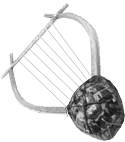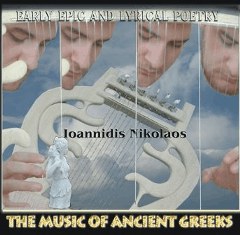|
The content of this CD is a collection of audio
files extracted from the first part of a very wide in
scope multimedia project, (commissioned by HOMO
ECUMENICUS Publishing), which explores the whole range of
ancient Greek music, but also of Greek culture in
general, because, in my view, the music of ancient Greeks
can not be studied separately from their literature,
poetry, drama, religion, and even their social and
political life. This first part deals with the early epic
and lyrical poetry and covers the period between the 8th
and 5th centuries B.C. The other parts' subjects are: the
Homeric Epics, the Orphic Hymns, the Dramatic Poetry (Aeschylous,
Sophocles, Euripides, Aristophanes), and the
music of the Hellenistic and Roman period.
Creating this project has been a great challenge for me
in many respects: As a musician, to compose and perform a
kind of music completely different from the mainstream,
the fruit of a long-time exploration in the roots of the
musical art, especially as this has been expressed in the
Mediterranean, the Middle East, the Balkans and Western
Europe. As an MA in Digital Media, by taking advantage of
the creative capabilities of the new media, to attempt to
reconstruct the musical experience of ancient Greeks not
only as sounds but also as texts, images, video and
interactive features. Finally, as a researcher in the
field of antique Greek culture and philosophy, to show
the timeless and classical value of this culture and to
argue that it is not a dead thing of the past but the
living heart of human civilization, evident in the
world's languages, in our thinking, in the organization
of our societies, and in every aspect of artistic
expression. The study of ancient Greek music in
particular (lyrics, metrics, modes, notation etc.) gives
sufficient evidence that this music lies in the
foundation of both the western and the eastern musical
tradition. The manner in which Western culture in
particular has expressed itself in the art of music has
been profoundly affected by Greek musical thought and
practice.

It is well known that the early
Christian church modes drew upon the ancient Greek modes.
First the Gnostics used the Greek scale in their
incantations, and then Byzantium not only adopted the
Greek modes but also adapted the verses of ancient poetry
to praise the God of the new religion. In the hymns of
today's Greek Orthodox Church which saved unaltered the
Byzantine tradition of the early Christian church, the
relationship with the ancient Orphic hymns, as well as
with the whole range of Greek poetry, both Lyrical and
Dramatic, is obvious. Also, the huge legacy of ancient
Greek writings on music theory served as models for later
theoretical treatises and helped shaped the course of
Western and, of course, Middle Eastern music theory.
There is no aspect of the musical art that the ancient
authors did not deal with: Writings on theory, musical
education and the role of music in society (by Plato and
Aristotle), on practical aspects of music performance
(Aristoxenus), on acoustics (Pythagoras, Euclid,
Ptolemeos) etc. Even the notational system, on which
today's Western music theory is based, comes from the
philosopher and mathematician Pythagoras (6th century
B.C.) who was the first to define musical intervals in
mathematical terms and thus create the first system of
musical notation. Finally, the organized system of
Western harmony, as expressed in the so called classical
music is actually the evolution of the music of the
Middle Ages, the organization of which, in turn, derives
from the medieval theorists' knowledge of ancient Greek
music transmitted to Europe by means of the works of
Boethius in the 5th century A.D and the writings of Arabs
later.
However, despite its immense
contribution to the world's musical culture, very little
is known about how the original Greek music actually
sounded. Surviving songs are for the most part fragments
that have been preserved either as quotations in the
works of biographers, metricians, and grammarians, or as
passages on papyrus strips, that had been used to wrap
mummies and stuff sacred animals in the Hellenistic
Egypt. Some notated fragments that have survived, written
in a relatively late Greek notational system, do not
provide adequate information for a safe reconstruction.
Also, some relics of ancient instruments that have
survived, are not playable, so our understanding of how
the music sounded rests solely on speculating on how the
particular constructions could work in terms of
acoustics.
Research in this particular field
becomes even more problematic from the fact that most
researchers come from disciplines other than music (they
are either archeologists or classicists) and also the
majority of them are non-Greek natives and, as a result,
not familiar with the language, or with the contemporary
Greek music, which is the natural child of the ancient
one. In my view, if they had a background in music and
also were familiar with the ancient language, they would
recognize the intrinsic rhythms and melodies of the
ancient verses, almost untouched by time, not only in
contemporary Greek traditional music but in the whole
range of humanity's musical endeavors. They could see,
for example, the ancient hymns, paeans, encomia, hymeneoi, partheneia, elegies, dithyrambs etc. in the
love songs, religious songs, dance songs, drinking songs,
laments etc. of contemporary Greek, Middle Eastern,
Balkan and European folk music. If they tried to play the
ancient Phrygian or Hypodorian modes using any stringed
instrument, they would be surprised by how western these
modes would sound, and they would see the close
connection of the ancient rhapsodists and aoidoi with the
medieval bards and troubadours, and even with today's
singer-songwriters. If they were familiar with the
ancient Greek culture, attempts to reconstruct the music
would not result in monotonous recitations, based on
stereotyped assumptions that Greek music consisted
entirely of melodies sung in unison, and that there was
no polyphony or complex arrangements. In my view, this
music, being the product of a highly sophisticated
culture, which encouraged free thinking and creativity and
thus created masterpieces in all fields of artistic
expression, could not be an exception.
On this principle I based my own
compositional approach, without however breaking the limits imposed by
the current status of archaeological evidence. As notation for the songs
of this particular collection has not survived, with regard to melody, I tried
to accommodate melodic principles to the demands of the
verses by creating melodic movement from the natural rise
and fall of the text.
The modes I used were those that seemed
to me most appropriate for the lyrical subject, mood, or
occasion on which the particular songs were likely to
have been performed. I made use of all modes (except for
the Mixolydian mode), but in the majority of compositions
I used combinations of the most common modes: Dorian, Lydian, and Phrygian.
With regard to rhythm, I used the rhythm
of the words, as this was dictated by the accentual
structure of the Ancient Greek language, as well as by
metrical structures. Actually, the intrinsic rhythm of
the verses revealed to me the whole range of all known
rhythmical patterns including my favorite odd signatures
like 9/8 and 7/8.
With regard to sound, in order to
emulate the ancient stringed instruments' sound, I used a copy of an
ancient kithara (the instrument featured on the CD cover), which I
patterned after surviving museum originals and iconographic
representations on sculptures and vase paintings. This instrument being a combination of a modern
classical guitar and a harp actually sounds both like a
guitar and a harp, and I believe that its sound can not
be very different of that of the original kithara. I also
used a modern classical guitar which I tuned like a
six-stringed barbitos or lyra, and which I played without
fretting. To emulate the sound of the ancient aulos (reedpipe), I used three woodwind instruments that
feature in the traditional music of Greece, Asia Minor
and the Middle East. They are the flogera, the zournas
and the ney. For percussion, I used the traditional Greek
instruments daires, defi and dumbek.
In my transcription of the Greek texts
I used all capital letters to avoid the problems associated with Greek fonts. Also, in order to make them more
readable I had to speculate on the missing pieces and
take the risk of introducing elements, for the sake of
lyric flow.
Finally, with regard to the translations
of the Greek texts which was not easy, due to the
fragmented nature of the material, I tried to make them
as literally as possible, while being faithful to the
original Greek text, that is by showing how phrase
follows phrase.
I believe that my approach, having been
based on the findings of a deep research and the
utilization of all available archeological evidence
cannot be very far from the actual music of ancient
Greeks. My hope is that this work will contribute a
little to the research in the field of antique Greek
culture, which in our turbulent times becomes once more
extremely relevant
Nikolaos Ioannidis
September 2002

------------------------------------------------------------------------------
Editor's note:
The subject of the influence of Greek music on
the
musical cultures of the peoples,
who have been subject to classical Greek cultural influence,
has also been researched by the author in the framework of an academic research
project at the University of Sussex.
Information on this
research project is available at the URL:
http://homoecumenicus.com/ioannidis_doctoral_dissertation.htm
|




